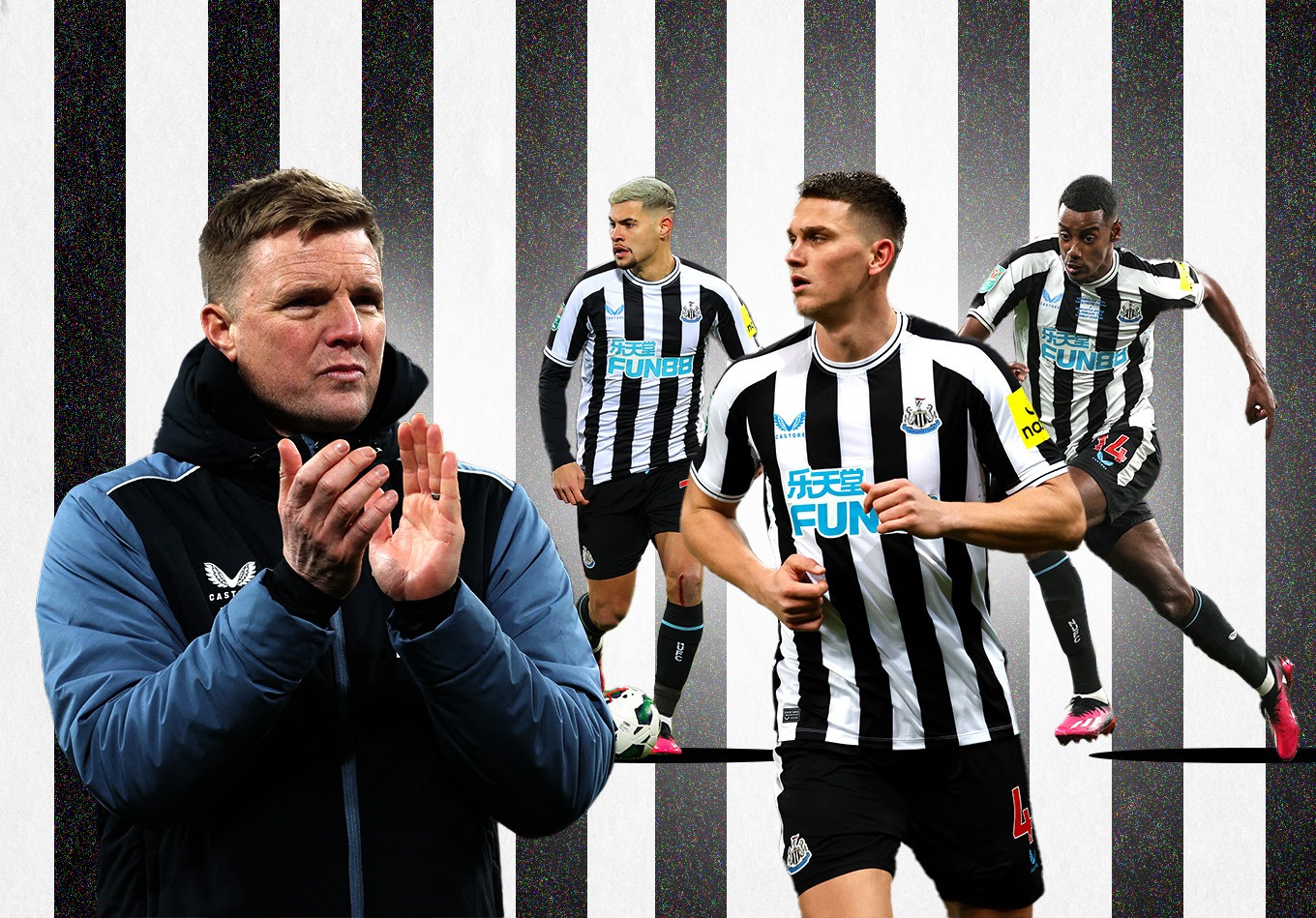Rarely do clubs bounce back from cup final defeats this quickly, but Newcastle United can shake this one off safe in the knowledge it is the beginning of something – a precursor to a new era of power and wealth following their controversial acquisition by the Saudi Arabia Public Investment Fund in 2021.
But while their future will be filled with forceful dominance and expectation, alongside accusations of financial doping and sportswashing like Manchester City before them, their appearance in this year’s EFL Cup final – and challenge for the top four – perhaps should not be judged on that basis. There has been so much talk of Newcastle’s ownership (and yes, something like £300 million has been spent in the last two years) that it might have blinded us to just how far ahead of schedule they are – thanks to the work of Eddie Howe.
His team are significantly overperforming, and Howe deserves credit for finding the perfect way to bridge the gap between Newcastle as relegation candidates and expectant title challengers.
Broadly speaking, the world’s best sides deploy high pressing and a high backline in order to dominate possession and territory while the weaker teams must hunch in a more defensive formation and wait for opportunities to counter-attack.
Howe’s Newcastle, as we show here, is a perfect midpoint between these two ideas: his fast transition-heavy football, built on defensive sturdiness in the middle third of the pitch, is pulling Newcastle up the pitch and through the first phase of their evolution.
Quick Transitions, Narrow Attacking Lines
Howe’s 4-3-3 is designed to sit predominantly in that central third, the lines ultra-compressed and the football defined by sudden and fast breaks in the transition (the moment when the ball is turned over and the opposition is dishevelled and vulnerable).
In terms of basic shape, generally left-back Dan Burn tucks in to make a back three so Kieran Trippier can move forward, while two free eights are joined by inverted wingers to give the number six – usually Bruno Guimaraes – options to funnel the ball through the centre.
And Newcastle really do pack the centre: their ‘absolute width’ per sequence is measured at 24.4 metres, the second lowest in the division behind Brentford. This narrowness helps Newcastle surround the opponent to create better pressing and more attacking transitions (more on that below) but also helps create surging counters as wingers Miguel Almirón and Joelinton or Allan Saint-Maximin run diagonally infield.
Only Liverpool and Arsenal average more ‘direct attacks’ per game than Newcastle’s 1.91 in the Premier League this season, plus they are fourth for through balls played (2.0 per 90) and top of the charts for sprints (153.3 per 90). Running directly at opponents is also crucial to how they play, with Newcastle third (behind Liverpool and Brighton) for number of take-ons leading to a shot attempt (1.3 per match). This directness can also be measured by their high rate of overall take-ons (18.8 per 90, the third most in the division) and by the fact only five clubs have recorded a lower number than Newcastle (176) in Opta’s measure of 10+ open-play pass sequences. Those other five are all in the bottom eight of the league table.
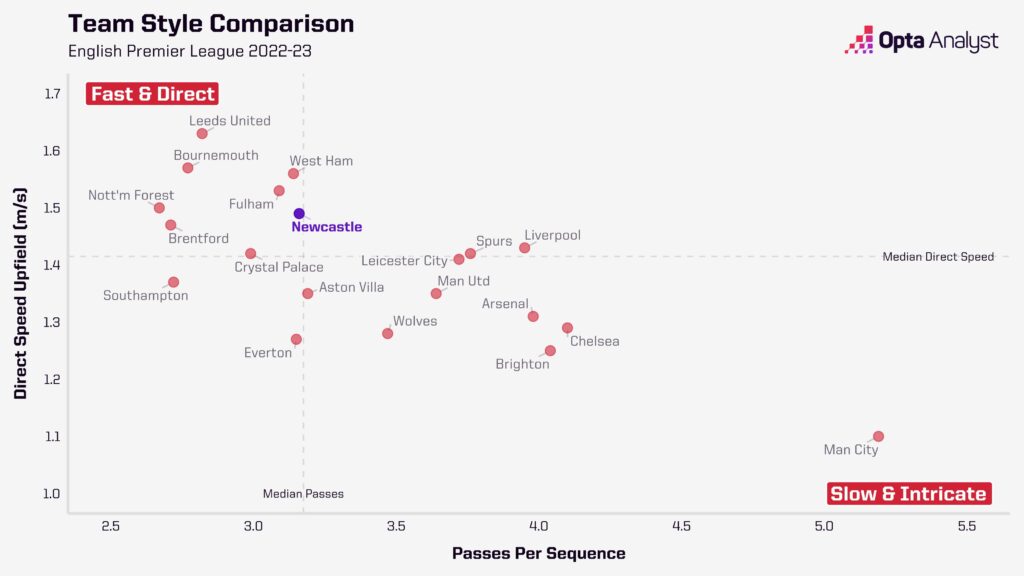
Despite this directness and narrowness, Newcastle do not score highly on many metrics regarding possession (their average is 51.4%) or chance creation: Howe’s side are mid-table in everything from shots on target (4.7 per match) to passes into the final third (28.4 per match). Again, this is a team not yet swarming and dominating their opponents, but rather occupying a halfway house between their old and future selves.
Hard Pressing – but Keeping Things in the Middle
On the defensive side of things, Newcastle’s strength is slightly over-stated by their goals against tally of 15, which is the league’s best. Their xG against is 22.6, which is the second best behind Manchester City but shows that Nick Pope’s form (who has prevented 2.9 goals from the shots on target he’s faced) has arguably made their defending look better than it is.
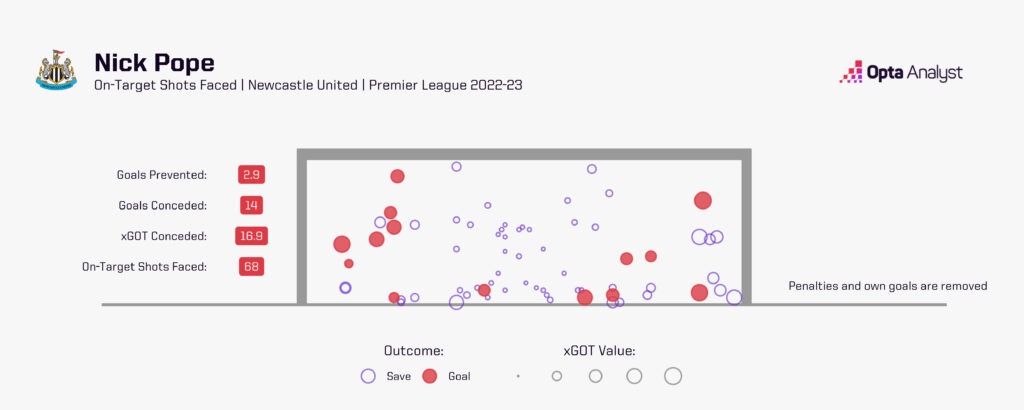
Nevertheless, they are performing well, and the basis for this is aggressive hard work in pressing the opposition – although again this is mainly in the middle of the pitch. Newcastle top the charts for the average duration of their presses (6.96 seconds); have the fourth lowest PPDA in the division (11.3) behind Leeds United, Brighton, and Chelsea; and rank in the top five for pressed sequences (15.3 per match). But tellingly, only 25.7% of their total pressures take place in the opposition third, putting them behind even West Ham United in eighth. Conversely, 52% of their pressures come in the middle third, up there with the highest in the league.
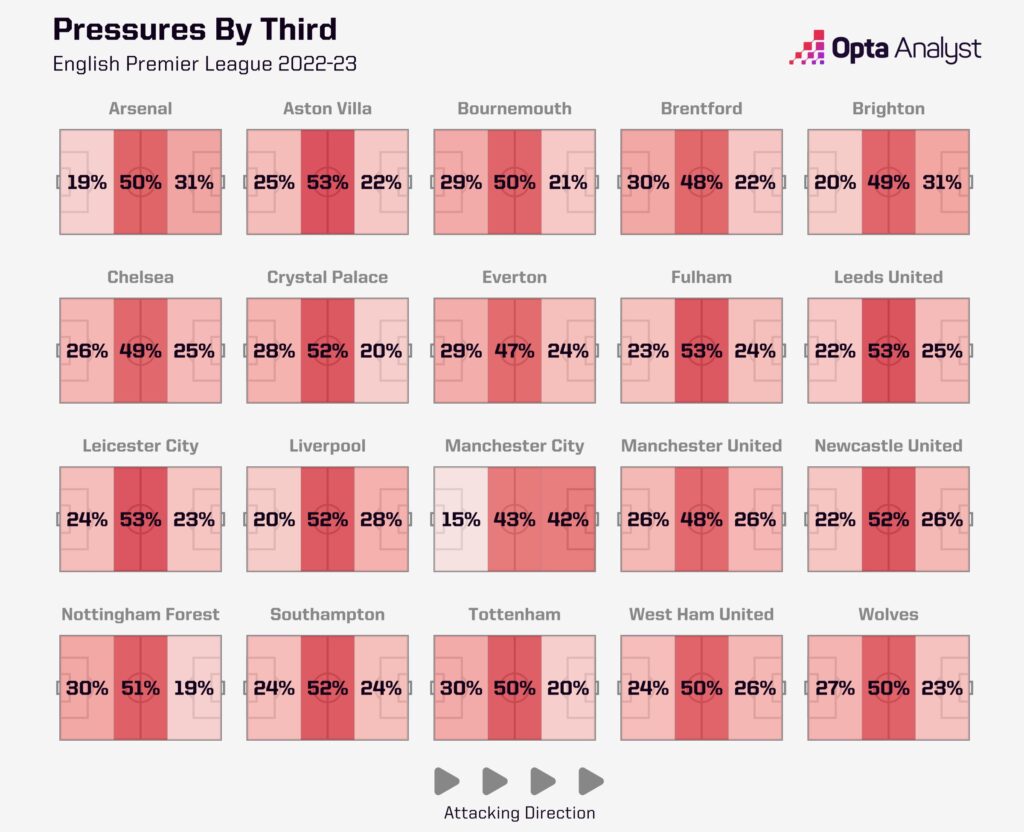
Magnetising things towards a compact and hard-working middle zone is a good way of preventing Newcastle from a) getting caught out on the break by opponents weaving out of a high press and b) getting caught dallying in their own third. On the latter point, it is telling that Newcastle have made the league’s fewest errors leading to a shot (four), perhaps because of the number of touches of the ball they take near their goal: they are 16th for touches in their own penalty area (57.6 per match) and 19th for touches in their defensive third (180.7 per match).
Howe’s team do not bother building attacks from deep. They rank sixth for long balls attempted (76.2 per match) while Pope generally plays it long: Newcastle’s goal kicks are the third longest in average distance (48.4 metres), behind Brentford and Southampton, and they rank 19th for the success rate of these goal kicks (72% hit their target). This is highly unusual for a team chasing Champions League football and again points to Howe finding a tactical middle point – literally, it turns out.
Isak and Saint-Maximin Show Newcastle Can Still Improve
Clearly leaving their own third alone is deliberate, but it is possible that Howe would like Newcastle to press higher and occupy more territory in the opposition third – or at least that’s what some intriguing numbers suggest. The good news for Newcastle supporters is that, in several main areas, there is obvious scope for improvement.
It is strange that Newcastle are third in the Premier League for take-ons attempted (18.8 per match) yet 17th for success rate (40.2%), and that despite their obvious work in attacking vertically and quickly through the lines Newcastle only have one player, Almirón, in the top 40 players for total number of forward runs made (575).
Howe has been reluctant to play Saint-Maximin this season because of his relative lack of work rate compared to other wingers, but his progressive carries per 90 (6.91) far outstrip his team-mates while Alexander Isak, also injured for most of the season, was very effective carrying the ball through the lines as a false nine in the second half of the EFL Cup final. These two can improve the numbers.
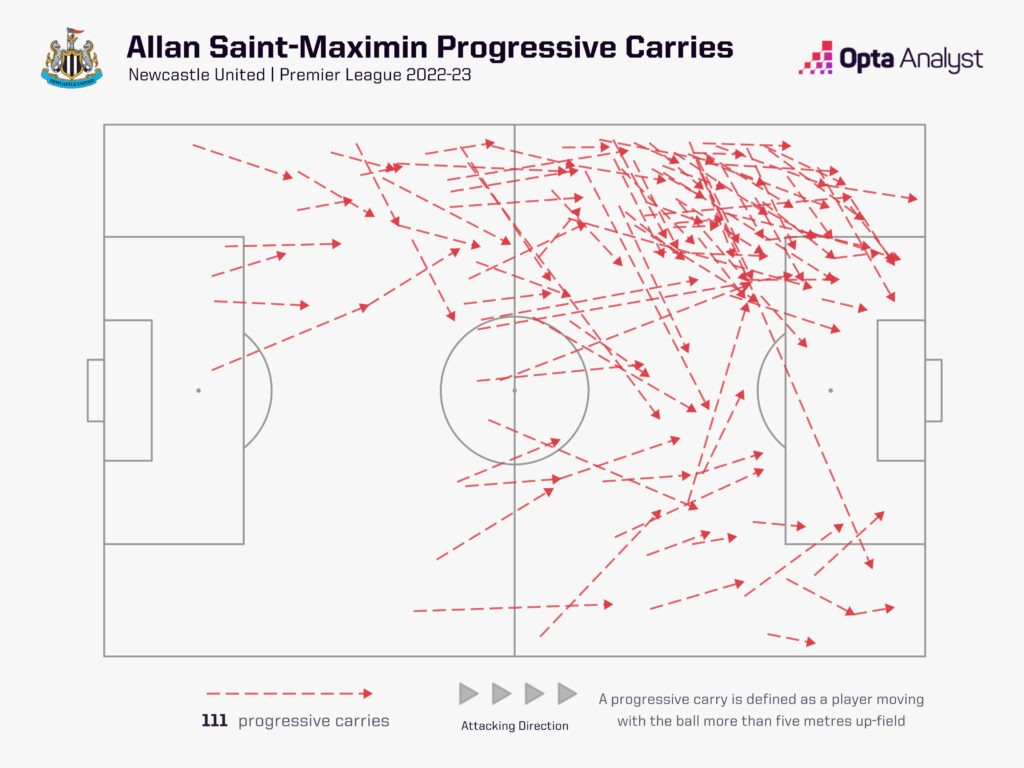
And that extra umph of directness from Saint-Maximin and Isak, the two most adventurous and talented attackers in the squad, could ultimately improve Newcastle’s pressing, too. It is notable that Newcastle rank fifth for high turnovers (210) but are right down in 18th for shot-ending high turnovers (24), ahead of only Brentford and Bournemouth. It could be that without the pace and ingenuity of Saint-Maximin and Isak Newcastle can’t convert transition opportunities into goalmouth action.
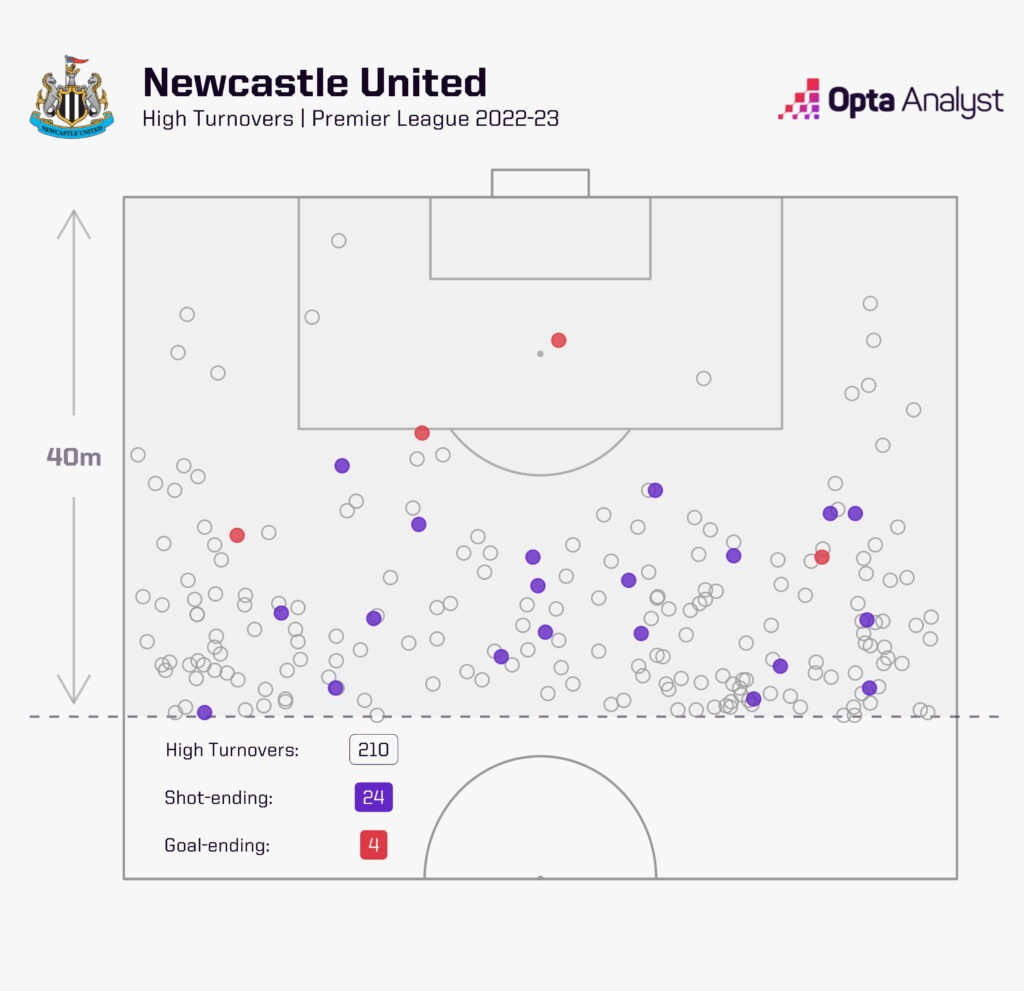
Finally, Newcastle are notably under-exploiting Trippier’s set-piece delivery: Newcastle have created 12.32 xG from set-pieces – by a distance the league’s best – but have only scored six goals. With time, they will surely progress to the mean and start putting more of these away.
Newcastle, then, need not worry about winning just one of their last seven Premier League matches. A downturn was bound to happen given the consistency of Howe’s selections (nine players have started 20 or more of their 23 league games), but with Isak and Saint-Maximin returning to the fore Newcastle have the players they need to move back up the table.
Defeat in the EFL Cup Final will be disappointing, but the fact they reached the final just 15 months after Howe took over is an indicator that final appearances will become the norm, not the exception, in this new era.
Enjoy this? Subscribe to our newsletter to receive five stories each Friday. It’s free.
